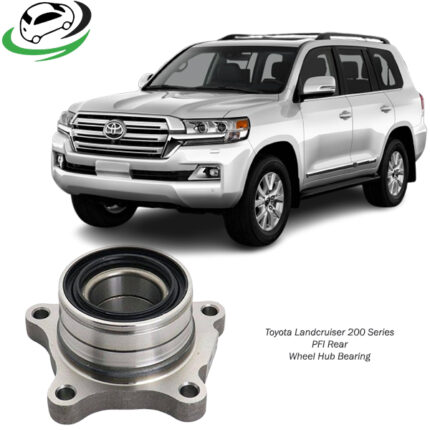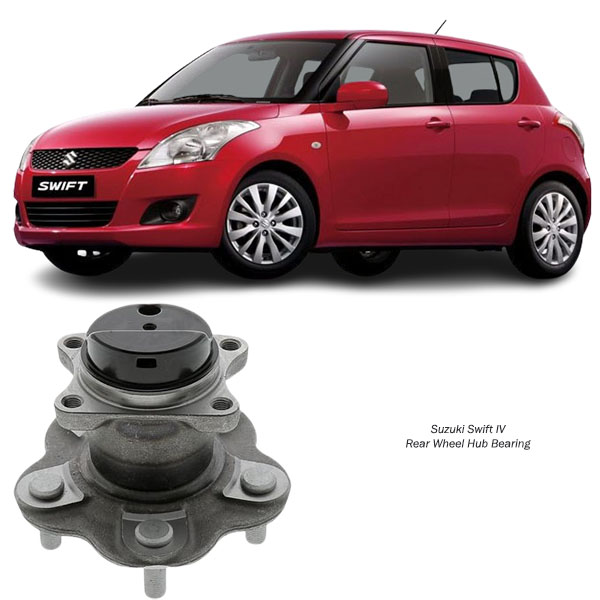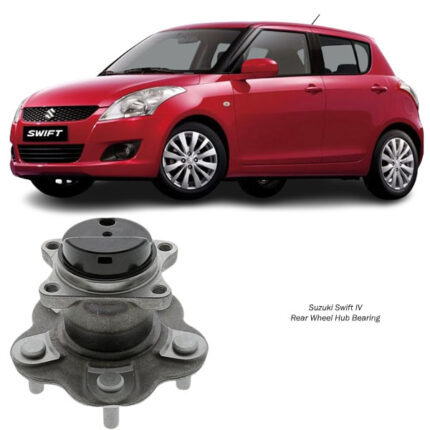-5%
Get Suzuki Swift IV Rear Wheel Hub Bearing PHU57645 in Kenya
The Rear Wheel Hub Bearing is a critical component of a vehicle’s drivetrain and suspension system. It plays a vital role in supporting the wheel’s movement, reducing friction, and ensuring smooth rotation. A failing wheel hub bearing can lead to dangerous driving conditions, increased rolling resistance, and even complete wheel detachment if left unaddressed.
1. What is a Rear Wheel Hub Bearing?
A rear wheel hub bearing is a sealed or greased bearing assembly that allows the rear wheels to rotate smoothly with minimal friction. It is located inside the wheel hub, which connects the wheel to the axle.
Main Components of a Rear Wheel Hub Bearing:
Outer Ring – The stationary part of the bearing.
Inner Ring – The rotating part connected to the axle.
Rolling Elements (Ball or Roller Bearings) – Reduce friction between the inner and outer rings.
Seal & Lubrication – Protects the bearing from dirt, moisture, and contaminants.
This compact yet powerful component ensures smooth wheel rotation, enhances fuel efficiency, and supports vehicle weight.
2. Function of a Rear Wheel Hub Bearing
The rear wheel hub bearing performs multiple functions that contribute to vehicle safety and performance.
Supports Wheel Rotation – Allows the wheel to spin freely while reducing friction.
Carries the Vehicle Load – Supports the weight of the vehicle and passengers.
Enhances Stability – Keeps the wheel securely attached to the axle.
Reduces Vibration & Noise – Minimizes friction and road vibrations.
Improves Fuel Efficiency – Ensures smooth rolling motion with minimal resistance.
A well-functioning wheel hub bearing improves handling, braking, and ride quality, making it a crucial part of the vehicle’s suspension system.
3. Types of Rear Wheel Hub Bearings
There are different types of wheel hub bearings based on design and application.
Ball Bearings
Uses small metal balls for smooth operation.
Common in passenger cars and light-duty vehicles.
Low friction but not ideal for heavy loads.
Tapered Roller Bearings
Uses cylindrical rollers instead of balls.
Found in trucks, SUVs, and heavy-duty vehicles.
Handles higher loads and side forces effectively.
Sealed Bearings
Pre-lubricated and sealed to prevent contamination.
Maintenance-free but requires complete replacement when worn out.
Hub Bearing Assembly (Integrated Hub Unit)
Combines the bearing, hub, and ABS sensor in one unit.
Used in modern vehicles for better durability.
Easier to install but costlier to replace.
The choice of bearing type depends on the vehicle’s weight, load capacity, and driving conditions.
4. Signs of a Failing Rear Wheel Hub Bearing
Like any other component, wheel hub bearings wear out over time. Here are common signs that indicate potential failure:
Humming or Growling Noise – A deep roaring or grinding sound that gets louder with speed.
Vibrations in the Rear Wheels – Excessive shaking or wobbling, especially at high speeds.
Uneven or Premature Tire Wear – Misaligned or loose bearings cause irregular tire wear.
Steering Instability – Difficulty keeping the car straight or sudden pulling to one side.
Increased Stopping Distance – Faulty bearings affect brake efficiency.
ABS Warning Light (For Hub Assemblies) – If the wheel speed sensor is integrated, failure may trigger the ABS warning light.
Ignoring these symptoms can lead to catastrophic failure, including wheel detachment while driving.
5. How to Replace a Rear Wheel Hub Bearing
Replacing a rear wheel hub bearing restores safety, performance, and ride comfort.
Tools Required:
Jack & Jack Stands
Lug Wrench
Socket & Ratchet Set
Pry Bar (if necessary)
Torque Wrench
Bearing Puller (if required)
New Rear Wheel Hub Bearing
Step-by-Step Replacement Guide:
Lift the Vehicle – Secure the car with jack stands and remove the rear wheel.
Remove the Brake Components – Take off the brake caliper, pads, and rotor.
Detach the Hub Assembly – Unbolt the old hub bearing from the axle.
Remove the Old Bearing – Use a bearing puller if the bearing is press-fitted.
Install the New Bearing – Align and secure the new hub bearing assembly.
Reattach the Brake Components – Reinstall the rotor, caliper, and brake pads.
Reinstall the Wheel & Lower the Vehicle – Tighten lug nuts properly.
Test Drive the Vehicle – Check for noise reduction and improved handling.
Safety Tip: Always replace bearings in pairs (left and right) to maintain balance.
6. Maintenance Tips for Longer Bearing Life
Proper maintenance extends the life of rear wheel hub bearings and prevents costly repairs.
Check Bearings Regularly – Inspect for noise, play, or wear.
Keep Bearings Lubricated (If Applicable) – Non-sealed bearings need periodic greasing.
Avoid Driving Through Deep Water – Water can seep in and cause rust or contamination.
Ensure Proper Wheel Alignment – Misalignment increases bearing stress.
Replace Bearings at Recommended Intervals – Typically between 80,000 to 120,000 miles.
Following these maintenance practices ensures smooth operation and longer bearing life.
7. Importance of a Well-Maintained Rear Wheel Hub Bearing
A properly functioning rear wheel hub bearing contributes to:
Smooth & Safe Driving – Reduces vibrations and noise.
Better Steering Control – Maintains precise wheel alignment.
Improved Braking Efficiency – Ensures proper stopping power.
Longer Tire Lifespan – Reduces uneven wear and tear.
Enhanced Fuel Efficiency – Reduces rolling resistance for better mileage.
Ignoring a worn-out wheel hub bearing can lead to severe damage, costly repairs, or even accidents.
Follow us on Facebook for more parts.




